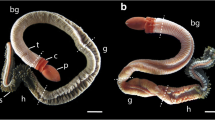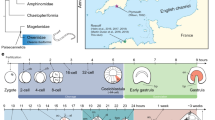Abstract
Development in the colonial ascidian genus Diplosoma is unusual in producing two zooids already during the free-swimming larval period. The development of D. listerianum had been investigated in two studies. The present study reports embryonic development of a second species D. migrans. In D. migrans the pharynx of the oozooid develops from two separate primordia. The intestinal tract develops as well from two distinct primordia that fuse and subsequently connect to the prospective pharynx. The pharynx of the blastozooid develops from the paired epicardia of the oozooid. In the oozooid the primordia of the peribranchial sacs often derive from the endodermal wall of the prospective pharynx, but occasionally develop from thickenings of the ectodermal epidermis. No atrial siphon is formed; instead, the body wall retracts and the gill slits open directly to the exterior. In the oozooid the rectum develops from the initial prospective intestine, while the remaining intestine develops from a diverticulum of the stomach. In the blastozooid the main part of the intestinal tract develops from the initial prospective intestine, whereas the rectum develops as a diverticulum of the initial intestine. Due to this developmental mode, the intestinal tracts of oozooid and blastozooid are transitorily connected at the respective border of rectum and proximal part of posterior intestinal tract. The paired epicardia of the two zooids derive from the epicardial outgrowths of the pharyngeal primordia of the oozooid that are also the primordia of the heart and pericardia. Budding in the larva and the adult is highly similar, in particular concerning the development of a new thorax and the heart from paired epicardial Anlagen and the origin of the distal part of the posterior intestine. Discrepancies in the descriptions of the embryonic development of D. listerianum and differences to the development in D. migrans are discussed. The development of the pericardium-heart-complex from epithelially organized tissue constitutes the plesiomorphic condition within Didemnidae and Aplousobranchiata. The development from mesenchymatic cell masses is a secondarily derived simplification.

















Similar content being viewed by others
Availability of data and material
All slides are stored by the author and made accessible upon request.
Notes
Because of the correspondences in development of these structures between oozooids and blastozooids, Groepler (2016) named these tubes “epicardial tubes”. Here, however, the more neutral, purely descriptive term “tube” is used, because the true epicardia of the oozooid are not developed in these stages.
The statement by Groepler (2016, p. 71) to that effect is premature in this respect.
References
Berrill NJ (1929) Studies in tunicate development. 1. General physiology and development of simple ascidians. Phil Trans R Soc Lond B 218:37–78
Berrill NJ (1950) The Tunicata with an account of the British species. The Ray Society, London
Caullery M (1895) Contributions a 1′etude des Ascidies composées. Bull Sci France Bel 27:1–158
Groepler W (1992) Über die Knospung sowie die vegetative Vermehrung und den Lebensraum der Kolonien von Diplosoma migrans (Menker & Ax, 1970) (Tunicata, Ascidiacea, Didemnidae). Zool Beitr NF 34:3–33
Groepler W (2016) Die Seescheiden von Helgoland—Neue Brehm-Bücherei. Verlags KG Wolf, Magdeburg
Hirano T, Nishida H (2000) Developmental fates of larval tissues after metamorphosis in the ascidian, Halocynthia roretzi. II. Origin of endodermal tissues of the juvenile. Dev Gen Evol 210:55–63
Kawamura K, Sugino Y, Sunanaga T, Fujiwara S (2008) Multipotent epithelial cells in the process of regeneration and asexual reproduction in colonial tunicates. Dev Growth Differ 50:1–11
Konopisceva LA (1975) Development of double larvae in Diplosoma listerianum. Zoologicheskii Zhurnal 54:712–726
Lafargue F (1968) Les peuplements sessiles de l’archipel de Glénan. II. Les Didemnidae. Systématique Ecologie Vié et Milieu 19:355–446
Pizon A (1893) Histoire de la blastogenese chez les Botryllides. Ann Sci Nat Zool 14:1–368
Pizon A (1905) L’evolution des Diplosomes (Ascidies composees). Arch Zool Exper Gen 4:1–6
Romeis B (1968) Mikroskopische Technik. R Oldenbourg Verlag, München, Wien
Salensky W (1894) Beiträge zur Entwicklungsgeschichte der Synascidien. 1. Über die Entwicklung von Diplosoma Listeri. Mitt Zool Stat Neapel 11:368–472
Salensky W (1895) Beiträge zur Entwickelungsgeschichte der Synascidien. II.Über die Entwickelung von Didemnum niveum. III. Algemeiner Theil. Mitt Zool Stat Neapel 11:488–630
Van den Breede P (1948) Le role des epicardes dans le bourgeonnement des Didemnidae. Ann Soc R Zool Belg 79:37–59
Acknowledgements
The authors would like to express their sincere gratitude to Johannes Zappe for his expertise and invaluable help in preparation of the figures.
Author information
Authors and Affiliations
Corresponding author
Ethics declarations
Conflict of interest
No competing interests.
Additional information
Publisher's Note
Springer Nature remains neutral with regard to jurisdictional claims in published maps and institutional affiliations.
Rights and permissions
About this article
Cite this article
Groepler, W., Stach, T. On organ development in larvae of Diplosoma migrans (Menker & Ax, 1976) (Tunicata, Ascidiacea, Didemnidae). Zoomorphology 138, 493–509 (2019). https://doi.org/10.1007/s00435-019-00454-4
Received:
Revised:
Accepted:
Published:
Issue Date:
DOI: https://doi.org/10.1007/s00435-019-00454-4




